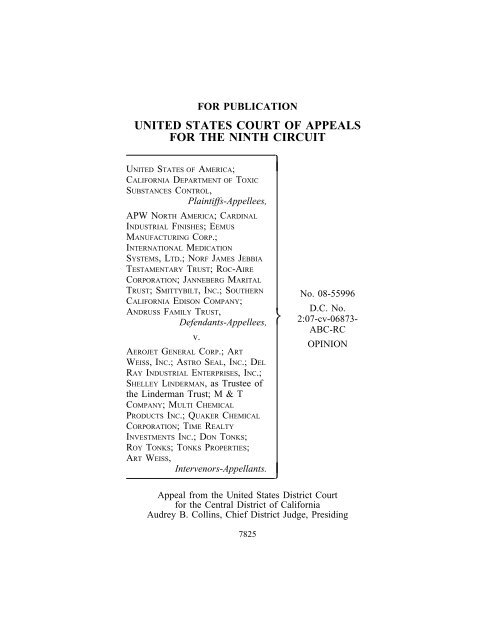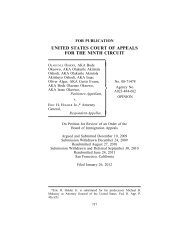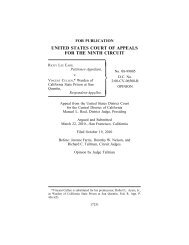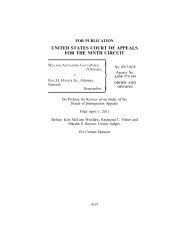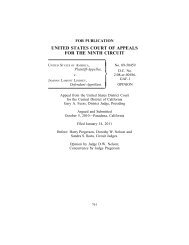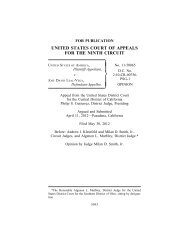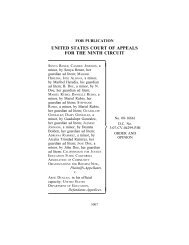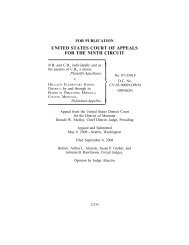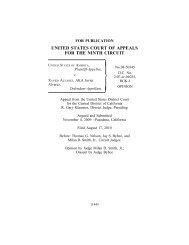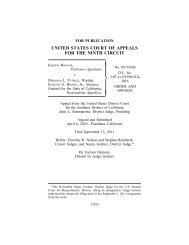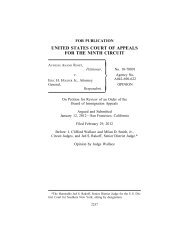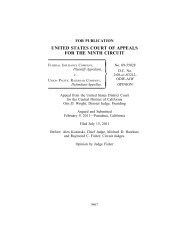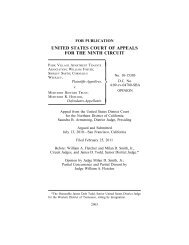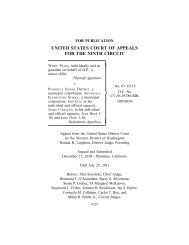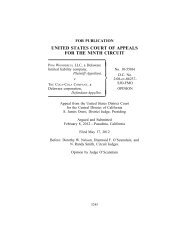United States v. Aerojet General - Ninth Circuit Court of Appeals
United States v. Aerojet General - Ninth Circuit Court of Appeals
United States v. Aerojet General - Ninth Circuit Court of Appeals
Create successful ePaper yourself
Turn your PDF publications into a flip-book with our unique Google optimized e-Paper software.
FOR PUBLICATION<br />
UNITED STATES COURT OF APPEALS<br />
FOR THE NINTH CIRCUIT<br />
UNITED STATES OF AMERICA;<br />
CALIFORNIA DEPARTMENT OF TOXIC<br />
SUBSTANCES CONTROL,<br />
Plaintiffs-Appellees,<br />
APW NORTH AMERICA; CARDINAL<br />
INDUSTRIAL FINISHES; EEMUS<br />
MANUFACTURING CORP.;<br />
INTERNATIONAL MEDICATION<br />
SYSTEMS, LTD.; NORF JAMES JEBBIA<br />
TESTAMENTARY TRUST; ROC-AIRE<br />
CORPORATION; JANNEBERG MARITAL<br />
TRUST; SMITTYBILT, INC.; SOUTHERN No. 08-55996<br />
CALIFORNIA EDISON COMPANY;<br />
ANDRUSS FAMILY TRUST,<br />
D.C. No.<br />
Defendants-Appellees, 2:07-cv-06873-<br />
ABC-RC<br />
v.<br />
AEROJET GENERAL CORP.; ART<br />
WEISS, INC.; ASTRO SEAL, INC.; DEL<br />
RAY INDUSTRIAL ENTERPRISES, INC.;<br />
SHELLEY LINDERMAN, as Trustee <strong>of</strong><br />
the Linderman Trust; M & T<br />
COMPANY; MULTI CHEMICAL<br />
PRODUCTS INC.; QUAKER CHEMICAL<br />
CORPORATION; TIME REALTY<br />
INVESTMENTS INC.; DON TONKS;<br />
ROY TONKS; TONKS PROPERTIES;<br />
ART WEISS,<br />
Intervenors-Appellants.<br />
OPINION<br />
Appeal from the <strong>United</strong> <strong>States</strong> District <strong>Court</strong><br />
for the Central District <strong>of</strong> California<br />
Audrey B. Collins, Chief District Judge, Presiding<br />
7825
7826 UNITED STATES v. AEROJET GENERAL CORP.<br />
Argued and Submitted<br />
October 5, 2009—Pasadena, California<br />
Filed June 2, 2010<br />
Before: Cynthia Holcomb Hall, William A. Fletcher and<br />
Richard R. Clifton, <strong>Circuit</strong> Judges.<br />
Opinion by Judge William A. Fletcher
7828 UNITED STATES v. AEROJET GENERAL CORP.<br />
COUNSEL<br />
M. Alice Thurston, Lisa Elizabeth Jones, US DEPARTMENT<br />
OF JUSTICE, Washington, D.C., Elizabeth Ann Rushton,
UNITED STATES v. AEROJET GENERAL CORP.<br />
OFFICE OF THE CALIFORNIA ATTORNEY GENERAL,<br />
Los Angeles, California, for the plaintiffs-appellees.<br />
Brian Donald Langa, DEMETRIOU, DEL GUERCIO,<br />
SPRINGER & FRANCIS, Los Angeles, California, Catherine<br />
Mitchell Wieman, Peter A. Nyquist, ALSTON & BIRD, Los<br />
Angeles, California, Robert Stephen Niemann, SEYFARTH<br />
SHAW, San Francisco, California, Carla Margolis Blanc,<br />
SOUTHERN CALIFORNIA EDISON COMPANY, Rosemead,<br />
California, for the defendants-appellees.<br />
James Carlyle Macdonald, Thomas Jay Bois, II, BOIS &<br />
MACDONALD, Irvine, California, Bradley L. Bunch, LAW<br />
OFFICES OF McCOLLUM & BUNCH, Fresno, California,<br />
Stephen Robert Onstot, WALSWORTH FRANKLIN BEV-<br />
INS & McCALL, Los Angeles, California, Stephen Arthur<br />
Tuggy, LOCKE LORD BISSELL & LIDDELL, Los Angeles,<br />
California, Lawrence Allen Hobel, COVINGTON & BURL-<br />
ING, San Francisco, California, for the intervenors-appellants.<br />
OPINION<br />
W. FLETCHER, <strong>Circuit</strong> Judge:<br />
7829<br />
The Comprehensive Environmental Response, Compensation,<br />
and Liability Act, 42 U.S.C. §§ 9601-9675<br />
(“CERCLA”), requires certain polluters to pay for cleaning up<br />
contaminated sites. After identifying a contaminated site, the<br />
federal Environmental Protection Agency (“EPA”) and state<br />
environmental agencies typically negotiate with potentially<br />
responsible parties (“PRPs”) over their shares <strong>of</strong> comparative<br />
responsibility for cleanup (“response”) costs. CERCLA<br />
allows PRPs to seek contribution from one another in order to<br />
apportion response costs equitably. But CERCLA bars contribution<br />
claims against PRPs that have obtained administratively<br />
or judicially approved settlements with the government.
7830 UNITED STATES v. AEROJET GENERAL CORP.<br />
CERCLA thus provides an incentive for PRPs to settle by<br />
leaving non-settling PRPs liable for all <strong>of</strong> the response costs<br />
not paid by the settling PRPs.<br />
We consider a question that has split the federal courts:<br />
May a non-settling PRP intervene in litigation to oppose a<br />
consent decree incorporating a settlement that, if approved,<br />
would bar contribution from the settling PRP? We join the<br />
Eighth and Tenth <strong>Circuit</strong>s in holding that the answer is “yes.”<br />
I. Background<br />
A. Investigation and Negotiation<br />
The San Gabriel Basin is a groundwater reservoir in eastern<br />
Los Angeles County that serves as a source <strong>of</strong> drinking water<br />
for more than one million people. In 1979, the EPA discovered<br />
groundwater contamination in the basin. In 1984, it designated<br />
much <strong>of</strong> the basin as a site on the CERCLA National<br />
Priorities List for investigation and cleanup. The EPA divided<br />
the site into eight “Operable Units.” The South El Monte<br />
Operable Unit (“SEMOU”) covers approximately eight square<br />
miles in the south central portion <strong>of</strong> the San Gabriel Basin.<br />
The EPA’s initial investigation determined that SEMOU<br />
groundwater contained volatile organic compounds (“VOCs”)<br />
that required containment and remediation. Throughout the<br />
1990s, the EPA sent Notice <strong>of</strong> Liability Letters to PRPs,<br />
requesting that they participate in a Remedial Investigation<br />
and Feasibility Study (“RI/FS”). Thirty-three PRPs participated<br />
in the RI/FS process. By 1999, the EPA had completed<br />
the RI/FS and had identified numerous industrial facilities in<br />
the SEMOU that were potential sources <strong>of</strong> the VOCs.<br />
In September 2000, the EPA issued an Interim Record <strong>of</strong><br />
Decision (“IROD”) based on the RI/FS. The IROD prescribed<br />
a 30-year remedial plan to clean contaminants from the<br />
groundwater and stop their spread. As part <strong>of</strong> the plan, local
UNITED STATES v. AEROJET GENERAL CORP.<br />
7831<br />
water providers (“Water Entities”) would pump the contaminated<br />
water, clean the water, and then sell the treated water<br />
to their customers. The EPA projected the estimated cost <strong>of</strong><br />
VOC cleanup at $14 million, plus an additional $14 million<br />
for costs incurred by the state and federal governments.<br />
In March 2002, the EPA sent Special Notice Letters pursuant<br />
to § 122(e) <strong>of</strong> CERCLA, 42 U.S.C. § 9622(e), to 67 PRPs<br />
it had identified as current or former owners or operators <strong>of</strong><br />
facilities in the basin that had used hazardous substances. The<br />
letters asked the PRPs to present good faith <strong>of</strong>fers to comply<br />
with the IROD remedial plan and to pay the EPA’s past costs<br />
in the SEMOU.<br />
In the meantime, the Water Entities sought to require the<br />
PRPs to pay for the water treatment response costs. After<br />
lengthy negotiations, in July 2002 the Water Entities and thirteen<br />
PRPs (“Group <strong>of</strong> 13”) entered into an agreement (“G13<br />
Agreement”). The G13 Agreement provided that the Group <strong>of</strong><br />
13 would pay $4.7 million to fund VOC cleanup in exchange<br />
for a standstill agreement under which the Water Entities<br />
would agree not to bring suit against the group during the<br />
period that the funds were being used. The Water Entities also<br />
agreed to “use good faith efforts” to support efforts <strong>of</strong> the<br />
Group <strong>of</strong> 13 to obtain an approved settlement that would bar<br />
contribution claims by other PRPs against Group <strong>of</strong> 13 members.<br />
On August 28, 2003, the EPA issued a unilateral administrative<br />
order to 41 PRPs that had not yet entered into agreements<br />
or made good faith <strong>of</strong>fers, requiring each <strong>of</strong> them to<br />
take remedial action.<br />
The remedial plan contained in the 2000 IROD addressed<br />
only VOC contamination. Soon after the issuance <strong>of</strong> the<br />
IROD, the EPA detected perchlorate in SEMOU groundwater<br />
at concentrations higher than the state’s drinking water advisory<br />
levels. In 2005, the EPA issued an Explanation <strong>of</strong> Signif-
7832 UNITED STATES v. AEROJET GENERAL CORP.<br />
icant Differences (“ESD”) to update the IROD remedial plan<br />
to address perchlorate contamination.<br />
By 2007, estimated response costs had increased substantially.<br />
The EPA’s VOC response cost estimate had increased<br />
from $14 million to $26 million. The ESD estimated an additional<br />
$46 million for perchlorate remediation. The estimated<br />
costs incurred by the state and federal governments had also<br />
increased from $14 million to $15 million. The total cost to<br />
clean up VOC and perchlorate contamination in the SEMOU<br />
groundwater was now estimated at $87 million.<br />
B. Suits by the Water Entities (SEMOU Cases)<br />
While they were negotiating the agreement with the Group<br />
<strong>of</strong> 13, the Water Entities filed four suits in the Central District<br />
<strong>of</strong> California against other PRPs (the SEMOU Cases). 1 On<br />
March 31, 2003, the district court consolidated the four cases.<br />
Under the terms <strong>of</strong> the G13 Agreement, the Water Entities<br />
could not sue the Group <strong>of</strong> 13. However, the PRP defendants<br />
in the SEMOU Cases were not so bound. The defendants filed<br />
third-party complaints against the Group <strong>of</strong> 13, as well as<br />
against other PRPs not sued by the Water Entities. Their<br />
third-party complaints sought contribution from the Group <strong>of</strong><br />
13 and the other PRPs. The defendants also filed counterclaims<br />
against the Water Entities. The district court appointed<br />
a Special Master to facilitate settlement. In October 2004, the<br />
district court stayed discovery while the parties focused on<br />
settlement discussions.<br />
1 The SEMOU Cases are: San Gabriel Basin Water Quality Authority v.<br />
<strong>Aerojet</strong>-<strong>General</strong> Corp., No. CV 02-4565; San Gabriel Valley Water Co.<br />
v. <strong>Aerojet</strong>-<strong>General</strong> Corp., No. CV 02-6346; Southern California Water<br />
Co. v. <strong>Aerojet</strong>-<strong>General</strong> Corp., No. CV 02-6340; City <strong>of</strong> Monterey Park v.<br />
<strong>Aerojet</strong>-<strong>General</strong> Corp., No. CV 02-5909.
UNITED STATES v. AEROJET GENERAL CORP.<br />
C. Agreement among the EPA, the Water Entities, and the<br />
Group <strong>of</strong> 10<br />
In March 2007, ten PRPs from the Group <strong>of</strong> 13 (“Group <strong>of</strong><br />
10”) entered into an agreement with the Water Entities, the<br />
EPA, and the state (“G10 Agreement”). The Group <strong>of</strong> 13 had<br />
become the Group <strong>of</strong> 10 when two members applied successfully<br />
for “ability to pay” status, see CERCLA § 122(g)(7), 42<br />
U.S.C. § 9622(g)(7), and a third member declined to participate.<br />
The Group <strong>of</strong> 10 agreed to provide an additional $3.4<br />
million to pay for cleanup <strong>of</strong> perchlorate contaminants in the<br />
SEMOU.<br />
D. Appeal in This Case<br />
7833<br />
In October 2007, the EPA filed a suit in the Central District<br />
<strong>of</strong> California against the Group <strong>of</strong> 10, lodging a proposed<br />
consent decree incorporating both the G13 Agreement <strong>of</strong><br />
2002 and the G10 Agreement <strong>of</strong> 2007. The consent decree, if<br />
approved by the court, would protect the Group <strong>of</strong> 10 from<br />
contribution claims by non-settling PRPs. The PRP defendants<br />
in the SEMOU Cases were not parties to the EPA’s suit.<br />
The Department <strong>of</strong> Justice published notice <strong>of</strong> the proposed<br />
consent decree in the Federal Register on November 8, 2007<br />
and provided a thirty-day public comment period. See Notice<br />
<strong>of</strong> Lodging <strong>of</strong> Two Consent Decrees, 72 Fed. Reg. 63,185<br />
(Nov. 8, 2007). A group <strong>of</strong> PRPs, including most <strong>of</strong> the<br />
defendants in the SEMOU Cases, submitted comments objecting<br />
to the proposed consent decree. We will call this group<br />
“Applicants.” Applicants did not include any <strong>of</strong> the Group <strong>of</strong><br />
13 or the Group <strong>of</strong> 10. Applicants complained that the EPA<br />
had not provided sufficient information about the proposed<br />
consent decree’s allocation <strong>of</strong> cleanup costs. Applicants further<br />
complained that they were “unaware as to whether [a<br />
Non-Binding Preliminary Allocation <strong>of</strong> Responsibility] has<br />
been prepared by EPA.” In December 2007, Applicants sub-
7834 UNITED STATES v. AEROJET GENERAL CORP.<br />
mitted Freedom <strong>of</strong> Information Act requests to the EPA. They<br />
received some information in response on February 19, 2008.<br />
In March 2008, Applicants moved to intervene as <strong>of</strong> right<br />
in the EPA’s suit against the Group <strong>of</strong> 10 under Federal Rule<br />
<strong>of</strong> Civil Procedure 24(a)(2) and § 113(i) <strong>of</strong> CERCLA, 42<br />
U.S.C. § 9613(i). The district court denied intervention and<br />
entered the consent decree the next day.<br />
The Applicants timely appealed, contending that the district<br />
court erred in denying their motion to intervene as <strong>of</strong> right<br />
under Rule 24(a)(2) and § 113(i). That appeal is before us in<br />
this case.<br />
E. Appeal in the SEMOU Cases<br />
In the SEMOU Cases, plaintiff Water Entities and thirdparty<br />
defendants Group <strong>of</strong> 10 requested a judicial order in<br />
May 2008 approving a proposed settlement between plaintiffs<br />
and third-party defendants that mirrored the proposed consent<br />
decree in the EPA’s suit against the Group <strong>of</strong> 10. Defendants<br />
in the SEMOU Cases included the Applicants who had sought<br />
to intervene to oppose the proposed consent decree in the suit<br />
brought by the EPA against the Group <strong>of</strong> 10. The district<br />
court in the SEMOU Cases entered judgment approving the<br />
settlement, dismissing with prejudice all claims against the<br />
Group <strong>of</strong> 10, and barring any claims for contribution by nonsettling<br />
PRPs. Five <strong>of</strong> the defendants (all <strong>of</strong> whom are Applicants<br />
for intervention in the suit brought by the EPA)<br />
appealed. That appeal is before us in a separate case. By separate<br />
order filed today, we vacate the district court’s judgment<br />
in the SEMOU Cases and remand for further proceedings consistent<br />
with this opinion. See San Gabriel Basin Water Quality<br />
Auth. v. Linderman, No. 08-56589.<br />
II. Standard <strong>of</strong> Review<br />
We review de novo a district court’s denial <strong>of</strong> a motion to<br />
intervene as <strong>of</strong> right, except for the court’s determination <strong>of</strong>
UNITED STATES v. AEROJET GENERAL CORP.<br />
timeliness, which we review for abuse <strong>of</strong> discretion. <strong>United</strong><br />
<strong>States</strong> v. Alisal Water Corp., 370 F.3d 915, 918-19 (9th Cir.<br />
2004); Calif. Dep’t <strong>of</strong> Toxic Substances Control v. Commercial<br />
Realty Projects, Inc., 309 F.3d 1113, 1118-19 (9th Cir.<br />
2002).<br />
III. Discussion<br />
The Applicants seek to intervene as <strong>of</strong> right under both<br />
Federal Rule <strong>of</strong> Civil Procedure 24(a)(2) and § 113(i) <strong>of</strong><br />
CERCLA. We require applicants for intervention as <strong>of</strong> right<br />
pursuant to Rule 24(a)(2) to meet a four-part test:<br />
(1) the motion must be timely; (2) the applicant must<br />
claim a “significantly protectable” interest relating to<br />
the property or transaction which is the subject <strong>of</strong> the<br />
action; (3) the applicant must be so situated that the<br />
disposition <strong>of</strong> the action may as a practical matter<br />
impair or impede its ability to protect that interest;<br />
and (4) the applicant’s interest must be inadequately<br />
represented by the parties to the action.<br />
California ex rel. Lockyer v. <strong>United</strong> <strong>States</strong>, 450 F.3d 436, 440<br />
(9th Cir. 2006) (quoting Sierra Club v. EPA, 995 F.2d 1478,<br />
1481 (9th Cir. 1993)). “In determining whether intervention<br />
is appropriate, courts are guided primarily by practical and<br />
equitable considerations, and the requirements for intervention<br />
are broadly interpreted in favor <strong>of</strong> intervention.” Alisal,<br />
370 F.3d at 919.<br />
Section 113(i) <strong>of</strong> CERCLA provides a right to intervene in<br />
almost identical terms to Rule 24(a)(2):<br />
In any action commenced under this chapter or under<br />
the Solid Waste Disposal Act in a court <strong>of</strong> the <strong>United</strong><br />
<strong>States</strong>, any person may intervene as a matter <strong>of</strong> right<br />
when such person claims an interest relating to the<br />
subject <strong>of</strong> the action and is so situated that the dispo-<br />
7835
7836 UNITED STATES v. AEROJET GENERAL CORP.<br />
sition <strong>of</strong> the action may, as a practical matter, impair<br />
or impede the person’s ability to protect that interest,<br />
unless the President or the State shows that the person’s<br />
interest is adequately represented by existing<br />
parties.<br />
42 U.S.C. § 9613(i). The two provisions differ only in providing<br />
a different burden <strong>of</strong> pro<strong>of</strong> for the fourth part <strong>of</strong> the test.<br />
Under Rule 24(a)(2), the burden <strong>of</strong> showing inadequate representation<br />
is on the applicant; under § 113(i), to avoid intervention,<br />
the government must show that the applicant’s<br />
interests are adequately represented. Commercial Realty Projects,<br />
309 F.3d at 1118-19.<br />
We consider the four parts in turn.<br />
1. Timeliness<br />
The parties do not dispute the timeliness <strong>of</strong> the Applicants’<br />
motion to intervene. Applicants acted promptly after learning<br />
<strong>of</strong> the proposed consent decree. They submitted comments,<br />
filed Freedom <strong>of</strong> Information Act requests, and ultimately<br />
moved to intervene, all within a span <strong>of</strong> four months.<br />
2. Significantly Protectable Interest<br />
An applicant for intervention must have a “significantly<br />
protectable interest,” meaning that “(1) it asserts an interest<br />
that is protected under some law, and (2) there is a ‘relationship’<br />
between its legally protected interest and the plaintiff’s<br />
claims.” Lockyer, 450 F.3d at 440-41 (citation and internal<br />
quotation marks omitted). Applicants here seek to intervene to<br />
protect their rights to contribution under CERCLA, and to<br />
ensure that the consent decree embodies a fair and reasonable<br />
allocation <strong>of</strong> liability.<br />
[1] By its plain language, CERCLA provides to a nonsettling<br />
PRP a statutory right to contribution from other PRPs.
UNITED STATES v. AEROJET GENERAL CORP.<br />
Section 113(f)(1) provides that “[a]ny person may seek contribution<br />
from any other person who is liable or potentially liable<br />
under section 9607(a) <strong>of</strong> this title, during or following any<br />
civil action under section 9606 <strong>of</strong> this title or under section<br />
9607(a) <strong>of</strong> this title.” 42 U.S.C. § 9613(f)(1). <strong>Court</strong>s are<br />
instructed to resolve contribution claims by allocating “response<br />
costs among liable parties using such equitable factors<br />
as the court determines are appropriate.” Id. Section 113(f)(2),<br />
however, makes the right <strong>of</strong> contribution unavailable against<br />
any PRP that enters into an approved settlement with “the<br />
<strong>United</strong> <strong>States</strong> or a State”:<br />
A person who has resolved its liability to the <strong>United</strong><br />
<strong>States</strong> or a State in an administrative or judicially<br />
approved settlement shall not be liable for claims for<br />
contribution regarding matters addressed in the settlement.<br />
Such settlement does not discharge any <strong>of</strong><br />
the other potentially liable persons unless its terms<br />
so provide, but it reduces the potential liability <strong>of</strong> the<br />
others by the amount <strong>of</strong> the settlement.<br />
42 U.S.C. § 9613(f)(2).<br />
7837<br />
[2] Only two circuits, the Eighth and the Tenth, have considered<br />
whether non-settling PRPs may intervene in litigation<br />
that threatens to cut <strong>of</strong>f their rights to contribution under<br />
§ 113(f). Both circuits have held that such PRPs have interests<br />
sufficient to support intervention as <strong>of</strong> right. See <strong>United</strong> <strong>States</strong><br />
v. Albert Inv. Co., Inc., 585 F.3d 1386 (10th Cir. 2009);<br />
<strong>United</strong> <strong>States</strong> v. Union Elec. Co., 64 F.3d 1152 (8th Cir.<br />
1995). District courts have split on the question. Compare<br />
<strong>United</strong> <strong>States</strong> v. Acorn Eng’g Co., 221 F.R.D. 530, 534-39<br />
(C.D. Cal. 2004) (holding interest not legally sufficient to<br />
support intervention as <strong>of</strong> right), <strong>United</strong> <strong>States</strong> v. ABC Indus.,<br />
153 F.R.D. 603, 607-08 (W.D. Mich. 1993) (same), and Arizona<br />
v. Motorola, Inc., 139 F.R.D. 141, 145-46 (D. Ariz.<br />
1991) (same), with <strong>United</strong> <strong>States</strong> v. Exxonmobil Corp., 264<br />
F.R.D. 242, 246-48 (N.D. W. Va. 2010) (holding interest
7838 UNITED STATES v. AEROJET GENERAL CORP.<br />
legally sufficient); <strong>United</strong> <strong>States</strong> v. Acton Corp., 131 F.R.D.<br />
431, 433-34 (D.N.J. 1990) (same).<br />
[3] We join the Eighth and Tenth <strong>Circuit</strong>s in holding that<br />
non-settling PRPs have a significant protectable interest in litigation<br />
between the government and would-be settling PRPs.<br />
As non-settling PRPs, Applicants in this case are potentially<br />
liable for response costs under § 107(a) <strong>of</strong> CERCLA, 42<br />
U.S.C. § 9607(a). Section 113(f)(2) provides that approval <strong>of</strong><br />
a consent decree will cut <strong>of</strong>f their contribution rights under<br />
§ 113(f)(1). The proposed consent decree in the EPA’s suit<br />
against the Group <strong>of</strong> 10 will therefore directly affect Applicants’<br />
interest in maintaining their right to contribution. See<br />
Union Elec., 64 F.3d at 1166-67. Further, because nonsettling<br />
PRPs may be held liable for the entire amount <strong>of</strong><br />
response costs minus the amount paid in a settlement, Applicants<br />
have an obvious interest in the amount <strong>of</strong> any judiciallyapproved<br />
settlement. See CERLCA § 107(a), 42 U.S.C.<br />
§ 9607(a); CERCLA § 122(h)(4), 42 U.S.C. § 9622(h)(4). The<br />
larger the settlement amount, the smaller the remaining<br />
amount for which the non-settling PRPs may be liable.<br />
Appellees contend that § 113(f)(1) creates only a contingent<br />
or speculative interest in non-settling PRPs, and that<br />
Applicants’ interest is therefore not significantly protectable.<br />
Some district courts have agreed. For example, the district<br />
court in <strong>United</strong> <strong>States</strong> v. Vasi determined that:<br />
Beazer’s [the applicant’s] potential right to contribution<br />
does not constitute a direct, substantial, legally<br />
protectable interest in the Vasi case. If anything,<br />
Beazer has a remote economic interest . . . .<br />
Beazer’s right to contribution is at present a contingency,<br />
and not something which it owns. Beazer has<br />
not been declared a responsible party, nor have the<br />
Vasi defendants been found responsible parties.
UNITED STATES v. AEROJET GENERAL CORP.<br />
Beazer cannot demonstrate that a substantial interest<br />
will be impaired by the Vasi proceedings.<br />
7839<br />
Nos. 5:90-cv-1167, 5:90-cv-1168, 1991 WL 557609, at *5<br />
(N.D. Ohio Mar. 6, 1991); see also Motorola, 139 F.R.D. at<br />
146 (<strong>of</strong>fering similar reasoning).<br />
[4] We disagree. Although only parties found liable can be<br />
made to pay a contribution claim, the statute explicitly provides<br />
an interest in such a claim to any “liable or potentially<br />
liable” person. CERCLA § 113(f)(1). Moreover, the statute<br />
provides that the interest arises during or following a civil<br />
action under §§ 106 or 107 <strong>of</strong> CERCLA. Therefore, under the<br />
statute, a non-settling PRP need not have first been found liable<br />
in order for the contribution interest to arise. See Union<br />
Elec., 64 F.3d at 1167 (“[N]o finding <strong>of</strong> liability is required,<br />
nor assessment <strong>of</strong> excessive liability, before the contribution<br />
interest arises.”).<br />
[5] These interests are sufficient to satisfy the requirements<br />
<strong>of</strong> Rule 24(a)(2) and § 113(i) that the interest be “significantly<br />
protectable.” CERCLA provides a contribution right and<br />
requires that consent decrees be substantively fair. See CER-<br />
CLA § 113(f)(1); <strong>United</strong> <strong>States</strong> v. Montrose Chem. Corp. <strong>of</strong><br />
Cal., 50 F.3d 741, 743 (9th Cir. 1995) (noting proposed consent<br />
decrees must be “fair, reasonable and consistent with the<br />
objectives <strong>of</strong> CERCLA”). Thus, Applicants’ interests in contribution<br />
and in a fair and reasonable allocation <strong>of</strong> liability are<br />
“protected under some law.” Lockyer, 450 F.3d at 440-41.<br />
There is a “relationship” between Applicants’ “legally protected<br />
interest and the plaintiff’s claims,” id., because the resolution<br />
<strong>of</strong> appellees’ claims will have a direct effect on<br />
Applicants. See Donnelly v. Glickman, 159 F.3d 405, 410 (9th<br />
Cir. 1998).<br />
Appellees would have us rely on arguments based on policy<br />
and legislative intent as a justification for concluding that<br />
non-settling PRPs’ interests are not sufficient to support inter-
7840 UNITED STATES v. AEROJET GENERAL CORP.<br />
vention. Some district courts have been persuaded by policy<br />
arguments against intervention, based upon the desirability <strong>of</strong><br />
giving the EPA leverage to encourage early settlement. These<br />
arguments include the desire “to ensure rapid and thorough<br />
cleanup <strong>of</strong> toxic waste sites,” Acorn, 221 F.R.D. at 536; to<br />
avoid “the expenditure <strong>of</strong> limited resources on protracted litigation,”<br />
id. at 537; and “to encourage early settlement by parties<br />
potentially responsible for cleanup costs,” Motorola, 139<br />
F.R.D. at 145. These courts believe that allowing intervention<br />
would be inconsistent with “CERCLA’s joint and several liability<br />
scheme and its policy favoring early settlements.” Id. A<br />
non-settling PRP “could refuse to engage in meaningful settlement<br />
negotiations” until other parties reached a settlement,<br />
and only then seek to intervene, which could “cause delays in<br />
implementation <strong>of</strong> the clean up . . . and effectively thwart the<br />
settlement process.” Vasi, 1991 WL 557609, at *4.<br />
There are, however, countervailing policy arguments in<br />
favor <strong>of</strong> treating all PRPs fairly, an interest that is itself<br />
embodied in the statutory scheme. Section 113(f)(1) confers<br />
a right to contribution on a non-settling PRP. Allowing nonsettling<br />
PRPs to intervene in CERCLA litigation to represent<br />
their own interests helps “ensure that the costs <strong>of</strong> [hazardous<br />
waste site] cleanup efforts [are] borne by those responsible for<br />
the contamination.” Burlington N. & Santa Fe Ry. Co. v.<br />
<strong>United</strong> <strong>States</strong>, 129 S. Ct. 1870, 1874 (2009). Further, even if<br />
intervention is allowed, the approval <strong>of</strong> a settlement will still<br />
cut <strong>of</strong>f the non-settling PRPs contribution interest, thus keeping<br />
intact “the intent <strong>of</strong> § 113(f)(2) to induce prompt settlement.”<br />
Union Elec., 64 F.3d at 1166.<br />
[6] But we do not rely on arguments based on policy. We<br />
agree with the Eighth and Tenth <strong>Circuit</strong>s that § 113(f) and<br />
113(i) <strong>of</strong> CERCLA are unambiguous. See Albert, 585 F.3d at<br />
1394-96; Union Elec., 64 F.3d at 1158 & n.1, 1165-66 (citing<br />
Hazardous Waste Treatment Council v. South Carolina (In re<br />
Sierra Club), 945 F.2d 776, 779 (4th Cir. 1991)). Section<br />
113(f) confers a right <strong>of</strong> contribution. Like Rule 24(a)(2),
UNITED STATES v. AEROJET GENERAL CORP.<br />
§ 113(i) confers a right to intervene on “any person” who<br />
“claims an interest” in the litigation, should the disposition <strong>of</strong><br />
the action “impair or impede” that interest. Section 113(i)<br />
contains no restriction on intervention by non-settling PRPs.<br />
See Union Elec., 64 F.3d at 1165. Nor does the right <strong>of</strong> intervention<br />
in § 113(i) need to be restricted in order to give effect<br />
to the contribution provisions <strong>of</strong> § 113(f). Indeed, precisely<br />
because § 113(f)(2) cuts <strong>of</strong>f the contribution right <strong>of</strong> nonsettling<br />
PRPs, § 113(i) gives them the right to intervene upon<br />
timely application. We therefore hold that Applicants have<br />
significant protectable interests that support intervention as <strong>of</strong><br />
right.<br />
3. Impairment <strong>of</strong> Interests<br />
7841<br />
[7] Under Rule 24(a)(2) and § 113(i), an applicant must be<br />
situated such that the disposition <strong>of</strong> the action may, as a practical<br />
matter, impair or impede its ability to protect its interests.<br />
[8] This requirement need not detain us long. It follows<br />
from our discussion <strong>of</strong> Applicants’ significant protectable<br />
interests that disposition <strong>of</strong> this action may impair or impede<br />
those interests. It is undisputed that “[d]isposition <strong>of</strong> the present<br />
litigation could bar or reduce the monetary value <strong>of</strong> the<br />
contribution claims <strong>of</strong> the prospective intervenors against the<br />
settling PRPs.” Union Elec., 64 F.3d at 1167. Non-settling<br />
PRPs may be held jointly and severally liable for the entire<br />
amount <strong>of</strong> response costs minus the amount <strong>of</strong> the settlement.<br />
CERCLA §§ 107(a) & 122(h)(4). Thus, as a practical matter,<br />
it is highly likely that the amount that the Group <strong>of</strong> 10 pays<br />
in settlement will affect the amount the non-settling PRPs<br />
ultimately have to pay, either in settlement or after trial, to<br />
satisfy their own liability for response costs.<br />
Proposed intervenors’ interests “might not be impaired if<br />
they have ‘other means’ to protect them,” even if the lawsuit<br />
would affect those interests. Lockyer, 450 F.3d at 442 (quoting<br />
Alisal, 370 F.3d at 921) (emphasis in original). But Appli-
7842 UNITED STATES v. AEROJET GENERAL CORP.<br />
cants have no such “other means” in this case. Appellees<br />
contend that Applicants have already protected their interests<br />
through participation in the SEMOU Cases, and that intervention<br />
here would replicate the process already made available<br />
in those cases. Participation in the SEMOU Cases, however,<br />
has not provided Applicants with a direct opportunity to challenge<br />
the fairness <strong>of</strong> the settlements prior to their entry as a<br />
consent decree.<br />
Appellees also contend that CERCLA’s notice and comment<br />
procedure provided Applicants with an “other means”<br />
by which to protect their interests. Notice and comment procedures<br />
do provide non-settling PRPs some degree <strong>of</strong> protection<br />
against an unfair consent decree. Some district courts<br />
have relied on the existence <strong>of</strong> these procedures to buttress a<br />
determination that intervention as <strong>of</strong> right is not available.<br />
See, e.g., Acorn, 221 F.R.D. at 538-39; <strong>United</strong> <strong>States</strong> v. Mid-<br />
State Disposal, Inc., 131 F.R.D. 573, 577 (W.D. Wis. 1990).<br />
We disagree with those courts. Once a consent decree has<br />
been negotiated and agreed upon, the interests <strong>of</strong> the government<br />
and would-be settling PRPs are essentially aligned and<br />
are adverse to those <strong>of</strong> non-settling PRPs who oppose entry<br />
<strong>of</strong> the decree. In the case now before us, Applicants had been<br />
involved in the settlement process and had made their views<br />
known to the government. The EPA and the Group <strong>of</strong> 10 had<br />
already agreed to the terms <strong>of</strong> the proposed consent decree,<br />
despite Applicants’ opposition, before comments were sought.<br />
It is unrealistic to expect the government to abandon or substantially<br />
modify the proposed consent decree in response to<br />
Applicants’ comments at this late stage <strong>of</strong> the process.<br />
[9] The statutory scheme reflects a Congressional intent<br />
that the interests <strong>of</strong> entities other than the government and settling<br />
PRPs be considered as part <strong>of</strong> the settlement process.<br />
When a settlement is submitted for judicial approval, a court<br />
is required to evaluate whether a proposed consent decree is<br />
“fair, reasonable and consistent with the objectives <strong>of</strong> CER-<br />
CLA” before approving it. Montrose, 50 F.3d at 743. A court
UNITED STATES v. AEROJET GENERAL CORP.<br />
must consider the substantive fairness <strong>of</strong> the consent decree<br />
to non-settling PRPs by assessing whether liability has been<br />
roughly apportioned based upon “some acceptable measure <strong>of</strong><br />
comparative fault.” <strong>United</strong> <strong>States</strong> v. Cannons Eng’g Corp.,<br />
899 F.2d 79, 87 (1st Cir. 1990); see Montrose, 50 F.3d at 746.<br />
Applicants have the right to participate in this process and to<br />
have their interests considered by the court. We conclude that<br />
the notice and comment procedure does not provide Applicants<br />
with sufficient “other means” by which to protect their<br />
interests, see Lockyer, 450 F.3d at 442, and that those interests<br />
will be impaired if Applicants are not afforded the right <strong>of</strong><br />
intervention.<br />
4. Adequacy <strong>of</strong> Representation<br />
7843<br />
“This <strong>Court</strong> considers three factors in determining the adequacy<br />
<strong>of</strong> representation: (1) whether the interest <strong>of</strong> a present<br />
party is such that it will undoubtedly make all <strong>of</strong> a proposed<br />
intervenor’s arguments; (2) whether the present party is capable<br />
and willing to make such arguments; and (3) whether a<br />
proposed intervenor would <strong>of</strong>fer any necessary elements to<br />
the proceeding that other parties would neglect.” Arakaki v.<br />
Cayetano, 324 F.3d 1078, 1086 (9th Cir. 2003).<br />
[10] The parties to this appeal do not contend that the<br />
existing parties adequately represent Applicants’ interests.<br />
Indeed, the would-be settling PRPs’ interests are directly<br />
opposed to those <strong>of</strong> the Applicants. The would-be settling<br />
PRPs wish to limit their share <strong>of</strong> liability and to bar the nonsettling<br />
PRPs from obtaining contribution. The EPA, having<br />
invested substantially in the settlement negotiations, has an<br />
interest in securing approval <strong>of</strong> the decree. These interests are<br />
directly opposed to those <strong>of</strong> the non-settling PRPs, who seek<br />
to challenge the proposed decree. “Because <strong>of</strong> this difference<br />
in interest, the EPA can hardly be expected to litigate with the<br />
interests <strong>of</strong> the non-settling PRPs uppermost in its mind.”<br />
Union Elec., 64 F.3d at 1170.
7844 UNITED STATES v. AEROJET GENERAL CORP.<br />
[11] Under Rule 24(a)(2), Applicants bear the burden <strong>of</strong><br />
showing that their interests are not adequately represented by<br />
the existing parties. Under § 113(i), the government bears the<br />
burden <strong>of</strong> showing the non-settling PRPs’ interests are adequately<br />
represented. Under either standard, we conclude that<br />
the interests <strong>of</strong> the non-settling PRPs are not adequately represented<br />
by the existing parties.<br />
Conclusion<br />
[12] For the foregoing reasons, we hold that Applicants<br />
have a right to intervene under Rule 24(a)(2) and § 113(i) <strong>of</strong><br />
CERCLA to protect their interests in contribution and in the<br />
fairness <strong>of</strong> the proposed consent decree. We therefore reverse<br />
and remand for further proceedings consistent with this opinion.<br />
REVERSED AND REMANDED.


